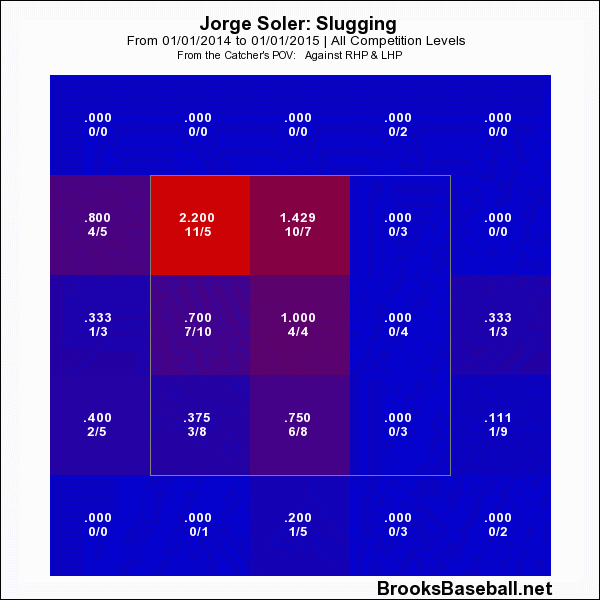This is The Beer List. It has nothing to do with beer, it’s just a list. But I like beer, and I hear that every once in a while, the folks who frequent Wrigley Field may take a sip as well. What we’re doing here is throwing out a question to the staff each week and they’ll share their thoughts. This week we ask: Which current team/player stat do you expect to change most over the course of the season?
Jorge Soler’s Contact Rate
During Spring Training, Joe Maddon compared Jorge Soler to “Vladimir Guerrero with plate discipline.” Len Kasper, who was enamored with Soler’s relative refusal to expand his strike zone during Cactus League play, heavily endorsed that observation. I winced. Guerrero was an exceptional talent, who succeeded in an exceptional, almost inimitable way. Drawing any parallel between a player and Guerrero is like comparing a pitcher to Greg Maddux.
To be sure, Soler looks nothing like Guerrero so far. Through his first 104 plate appearances, Soler struck out 38 times. In 1997, as a rookie, Guerrero fanned only 39 times in 354 plate appearances. More frustratingly, Soler’s plate discipline has also deserted him: he’s seeing very few strikes and swinging at pitches outside the zone at right about the average rate.
He’s going to correct himself, though, in at least one way. When Soler has swung at pitches inside the strike zone this season, his contact rate is over 83 percent. That puts him below the league average in that regard, but not by much. He also really punishes those pitches, especially when they’re anywhere from the middle of the zone inward:
Alas, on anything outside the zone, Soler might as well swing a hockey stick at the ball. His contact rate on those pitches is 36.7 percent, the third-worst figure in the league, for all batters who have seen at least 250 pitches this year. The raw difference between those numbers—83.2 percent contact in the zone, 36.7 outside it—is the second-largest in the league, and the percentage difference is the absolute highest.
I don’t think Jorge Soler is, in the long term, that kind of hitter. I don’t think he’ll struggle this much to make contact on pitches outside the zone as he finds his comfort zone at the plate. I think, instead, that these numbers are what happens when a naturally patient hitter gets more than a little bit antsy. Soler will start refining his approach, and that the strikeouts will slow down considerably. They just won’t stop, or drop to anywhere near the low level Guerrero established. —Matt Trueblood
Kyle Hendricks Four-seam Fastball and Cutter Usage
I think we’ll see Kyle Hendricks’ use of his four-seam fastball and cutter decrease over the course of the season. Right now, he’s firing the four-seam 8.1 percent of the time and the cutter is tossed 13.4 percent of the time. Neither pitch is thrown for a strike very often relative to his other pitches, nor do they generate many whiffs. Besides having below-average velocity, his hard pitches aren’t producing the ground balls—11.43 percent for the four-seam and 6.9 percent for the cutter—he needs them to.
He’s been giving up harder contact this season—32 percent compared to 24 percent in 2014—and while it’s a small sample, the slugging percentage against those two pitches suggest they’re the biggest culprits. I think Hendricks slowly starts to abandon the four-seam and cutter in favor of heavier use of his sinker and changeup to keep the ball on the ground. —Kevin Luchansky
Cubs Fans Sprained Thumbs
One regression that stat hounds will definitely see this season: a decline in the number of sprained thumbs Cubs fans suffer.
The injuries come from the multitude of angry tweets fans send whenever reliever Brian Schlitter enters a game, often featuring furious-yet-brilliant variations on Schlitter’s last name. (Ok, we’ll just come out and say it: they use the word “bitter.”)
“We’ve seen a lot of busted-up thumbs over the last several weeks,” says Dr. Ernest Alfredo, director of emergency room medicine at Northwestern Memorial Hospital. “Those fans must have been pretty irate.”
Alfredo says his E.R. treated hundreds of cases in the weeks before Schlitter’s demotion on April 27. The peak came on April 21, when Schlitter gave up two runs in less than an inning against the Pittsburgh Pirates.
But now, with the bearded Schlitter in Iowa and Justin Grimm returning to the Cubs’ bullpen, Alfredo thinks the rash of injuries will subside.
For his part, Schlitter has pitched well in his lone Iowa appearance, allowing 0 runs with one strikeout in one inning. More positively, he won yet another contest for most resembling Jim James, lead singer of My Morning Jacket.
—Joel Reese
Jon Lester’s 0-fer
Jon Lester will get a hit in 2015. Believe it. Look, anybody can start a career 0-48. Lester, however, has shown some life in 2015. Sure, I could show his spray chart with upwards of five ground balls. Or perhaps his .200 OBP in 2010.
Instead, I will first point to Lester’s 19 percent whiff rate is league average, meaning he is not just flailing and missing at the plate. Next, I will direct to the fact Lester has now put the ball in play in 50 percent of his at-bats. He is making contact and putting the ball on the ground; it is just a matter of time before one sneaks through. The hit is coming in 2015. Mark it down. —Andrew Felper
Number of People Calling for Starlin Castro to be Traded
No player so sharply divides Cubs fandom as does Starlin Castro. The young shortstop is already a three-time All-Star and is likely to reach 1,000 hits before his 26th birthday. Still, there’s no shortage of opinions on Castro and his future with this team. What makes this division of opinion so unique, of course, is how varied it is. For every few people who believe the Cubs should trade him for a pitcher now, there are just as many who believe they should hold on to him at all costs, while others yet feel he should move to second. Public opinion on Castro hinges on tiny moments in each game. He made an error? TRADE HIM! He made a diving stop? Trade Baez! This proves just how wild and crazy the logic gets when we’re dealing with fan opinion on Castro; so crazy that other players entirely get dragged into the conversation.
There are also so many factors to consider when thinking about people’s opinions on Castro. It can be so confusing sometimes that you might think we’re discussing how to achieve peace in the Middle East instead of the fate of a 25-year-old shortstop. The other parallel that this conversation shares with tense foreign policy debates is that everyone has a strong opinion on it, despite often misunderstanding the topic in the first place. Very few people when asked about Castro will ever just shrug their shoulders. The very mention of his name is sure to elicit a far greater response than you were hoping for. Thus, the number of people calling for a Castro trade is, in my opinion, the most volatile of all Cubs statistics. —David Blumberg
Anthony Rizzo Stolen-Base Frequency
It sounds simple when you explain it: get a good secondary lead, read the hell out of the pitcher, go on first move to home, and then slide safely into second. It looks even easier when you see the types of secondary leads Anthony Rizzo is getting off pitchers who, in spite of early evidence, refuse to believe Rizzo will steal second. But I’m here to tell you this: what Rizzo is doing on the basepaths is not easy.
Rizzo has nine stolen base attempts through 25 games. He’s been successfully an astonishing (for him) seven times, putting him on pace for a 40 stolen base season. “On pace” is a terrible notion this early in the season, but the frequency and success rate are notable. Paul Goldschmidt is largely seen as the best power/speed threat at first base and he stole nine bases all of last year (he has five this year). Rizzo looks like he’s in better shape, and the athleticism is apparent, but there’s no way he keeps attempting to steal bases at this rate. The success rate will take a hit once pitchers and catchers start paying attention to him on first and Rizzo will pick his spots better. It’s been impressive but ultimately it’s transient. Fleeting. Hold on to this while you can. —Mauricio Rubio, Jr.



Who is Jim James, really???